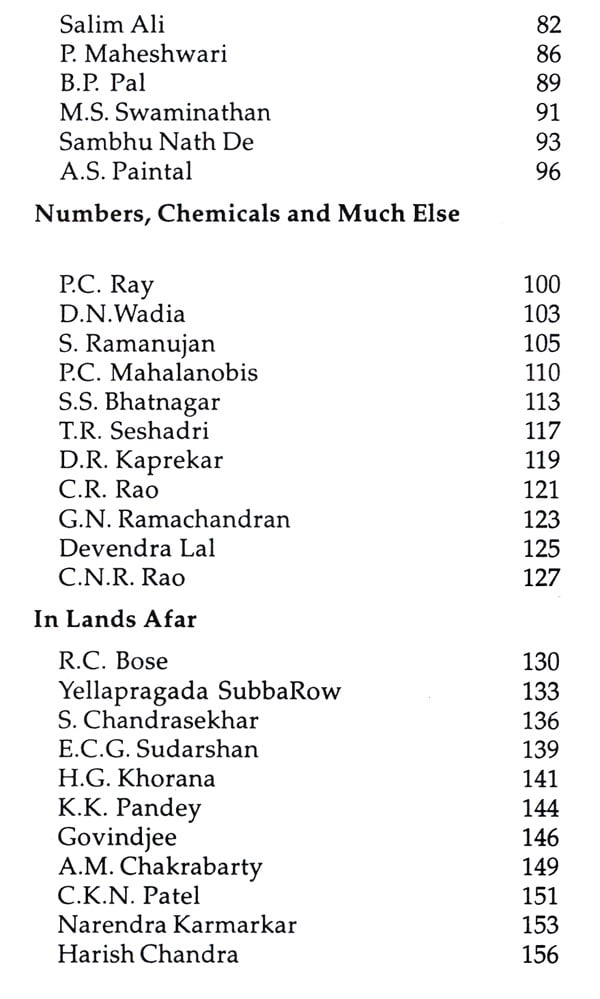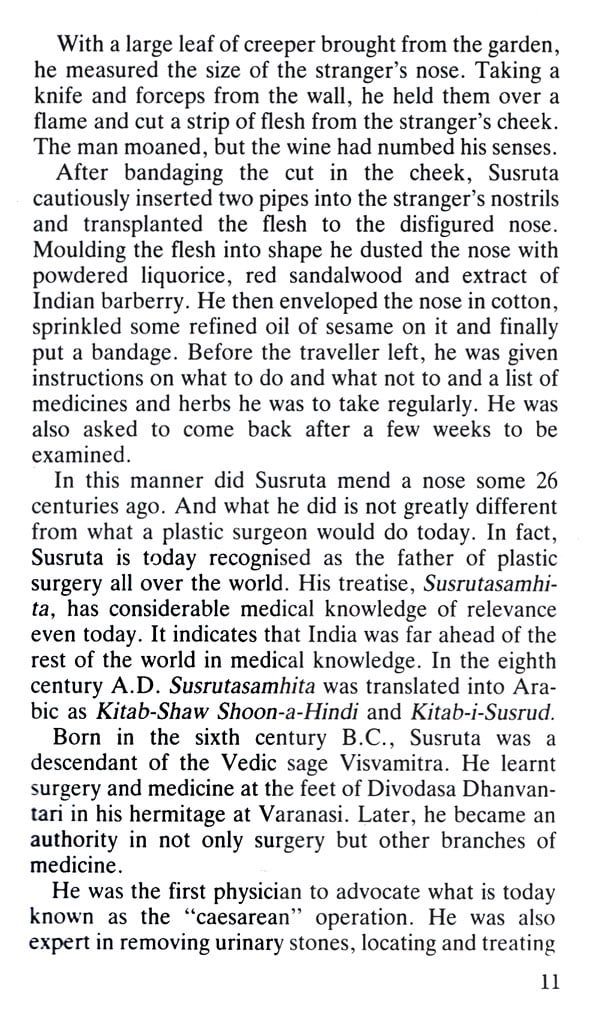
Scientists of India
Book Specification
| Item Code: | NAT803 |
| Author: | Dilip M. Salwi |
| Publisher: | Children's Book Trust |
| Language: | ENGLISH |
| Edition: | 2021 |
| ISBN: | 9788170113188 |
| Pages: | 158 (Throughout B/W Illustrations) |
| Cover: | PAPERBACK |
| Other Details | 8.50 X 5.50 inch |
| Weight | 210 gm |
Book Description
As early as 3,000 years before the birth of Christ, people of the Indian subcontinent had acquired knowledge of science which can only be described as amazing. This is evident from a variety of scientific phenomena propounded and discovered by them. Significant contributions were made to mathematics, astronomy and medical science. The concept of zero was discovered around the fifth century A.D. This book tells you about the origin of science in India, its phenomenal growth over the years and the people who contributed to it.
Most Indians are aware that they have a great heritage, but few would include science in it. This is mainly because during centuries of alien rule they have been led to believe that science is an import from Europe. They tend to forget the many significant 100 contributions to science India had made for hundreds 103 of years before the first Europeans came to India.
There is evidence that more than 3,000 years before 110 the birth of Christ, people of this sub-continent had 113 much scientific knowledge. Relics of the Indus Valley 117 civilization found at Harappa and Mohenjo-daro (now 119 in Pakistan) indicate that their cities were well-planned, 121 with excellent water supply and drainage systems. The 123 progress they had made in agriculture,brick-making, 125 craft and industry was remarkable. Their clothes were 127 made of cotton. For reasons yet unknown, this civilization decayed and was lost. The cities got buried.
With the coming of the Aryans to India around 2000 B.C. , about 1,000 years after the collapse of the Indus Valley civilization, a new page began in the history of science in the land. There is evidence to indicate that the Aryans had a scientific attitude. A natural law was 141 believed to govern the universe. This seemingly disordered and diverse world was explained in terms of the panchabhutas (five factors), namely, prithvi(earth), ap (water), tejas (heat), vayu (air) and akasa (sky). The human body was a combination of the panchabhutas and the soul.
The Aryans were a highly religious race. Every ritual or sacrifice was conducted at an auspicious hour determined by the planetary positions and in a precisely built temple. They were thus expert astronomers (or astrologers), mathematicians and geometricians. Their calendar was luni-solar, which was based on the movement of both the moon and the sun. They had identified various nakshatras (constellations) and had named the months after them.
In mathematics, they could count numbers even up to 1012, while the Greeks could count only upto 104 and the Romans upto 108. The Pythagorus theorem can also be traced to the Aryans' Sulbasutras. Values of irrational numbers such as V2 and V3 were also known to them to a high degree of approximation. Knowledge of permutation and combination is also found in the Vedic texts.
The theory that change of seasons, minute organisms in the body and hereditary factors cause disease was widely accepted. A system of medicine, Ayurveda, in which surgery had a special place was practised. Methods of surgical treatment were advanced and later the Arabs and the Greeks adopted them. Indian herbs were also sought after in the Roman world.
Besides the human body, the internal structure of plants and animals was also studied, their various parts identified and named. In agriculture, the method of "fallow rotation" — keeping the land untilled for some time after a series of crops had been sown and harvested — to improve the fertility of the soil was practiced.
The golden age of science in India was from the fourth century B.C. to the sixth or seventh century A.D. With prosperity in the land, science flowered under the Maurya, Shaka, Kushana and Gupta empires. There were renowned universities at Nalanda, Varanasi and Taxila (now in Pakistan). There was much exchange of scholars with neighbouring and distant lands.
Outstanding contributions were made to mathematics, astronomy and medical science. The concept of zero was discovered around the fifth century A.D. Another discovery was differential calculus, but it was not further explored.
The astronomical treatises, the Siddhantas, were also written during this period. One of them, the Suryasiddhanta, is known the world over for its accurate data. Texts were written on morphology, physiology and the germination process of plants. A system of nomenclature was also developed, which gave the botanical significance, therapeutic value and habitat of plants.
With the Muslim invasion in the 12th century, India's ancient culture and learning remained intact only in some pockets of Maharashtra and Gujarat and in southern India. But Sanskrit texts were translated into Persian and Arabic and what knowledge India had acquired was passed onto the Arab world and then to Europe.
While wars and invasions plagued India, Europe was passing through the Renaissance period of science. Copernicus's heliocentric theory of the universe, Galileo's astronomical discoveries and Isaac Newton's laws of motion had gained acceptance. The search for truth -- science — was catching up everywhere.
History was not on India's side. She could not participate in the Renaissance and become one of the earliest homes of modern science. After the Mughals came the Portuguese, the Dutch, the French and finally the British. These invasions wrought irreparable dam-age. Indians themselves forgot their glorious scientific past until the Indus Valley civilization was discovered in 1921.
A major benefit to Indian science during British rule was the spread of education in English, the language of modern science. The learning of science got a fillip in 1857 when three universities were created at Calcutta, Bombay and Madras. In 1876 a rich physician, Mahendra Lal Sircar, set up the first scientific research institution at Calcutta. Known as the Indian Association for the Cultivation of Science, it soon became the focus of scientific activities in pre-independence India. With India becoming independent on August 15, 1947, a new page was opened in the history of science in the land. There was a remarkable expansion of facilities for scientists. Research began and prospered in many fields. Progress was rapid, at times spectacular. India is now a member of the nuclear club, the space club, the Antarctica exploration club. It has the world's third largest pool of trained technologists, next only to the USA and the Soviet Union, though it is still a developing nation. While much remains to be done for India to catch up with the advanced countries, much has been done.
**Contents and Sample Pages**













